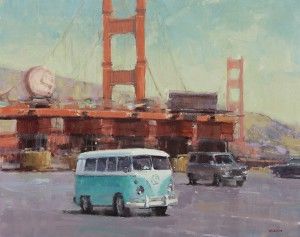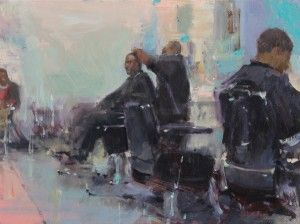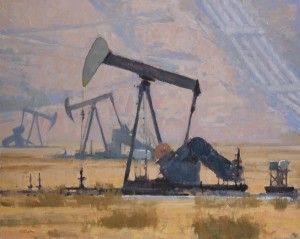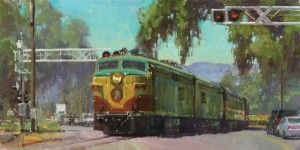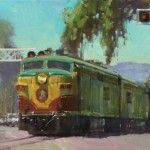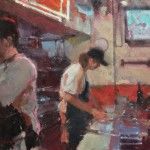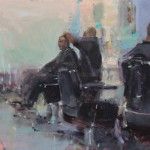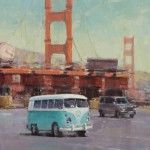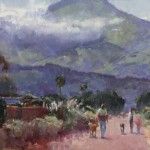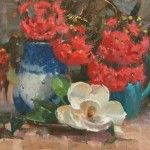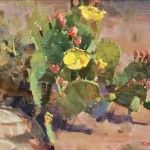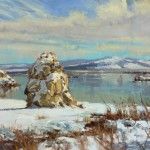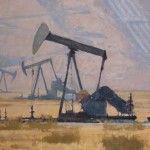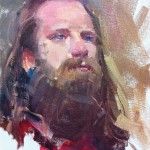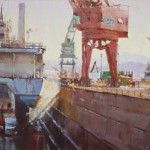Randall Sexton captures everyday life with a nod to nostalgia
By Bonnie Gangelhoff
This story was featured in the May 2016 issue of Southwest Art magazine. Get the Southwest Art May 2016 print issue or digital download now–then subscribe to Southwest Art and never miss another story.
A yellow Volkswagen Beetle, a roadside vegetable stand, a soapbox derby: On the surface, the subjects of Randall Sexton’s paintings don’t really seem to have much in common. But peruse his body of work carefully, and you may detect a delicate thread weaving in and out of his paintings—a sense of nostalgia. Ruminating on his penchant for remnants from earlier times, Sexton says the focus is not a conscious one. Subjects just seem to choose him the same way “cats choose their owners,” he says. “The muse hits me, and I think, this is what I am looking for. I try to be open and not be too cerebral or judgmental about my creative process.”
As this story was in progress, Sexton had just returned from the Maui Plein Air Painting Invitational in Hawaii. He was back in his California studio finishing paintings for an upcoming solo show at Debra Huse Gallery in Balboa Island, CA. Sexton’s studio is located in the small working-class town of Crockett, about 30 miles northeast of San Francisco. A former Nash Motors car dealership, the low-slung brick warehouse is also home to a frame shop, a credit union, and Epperson Gallery, which represents Sexton’s work. Crockett is the kind of place Sexton finds comfortable and familiar because it is reminiscent of the East Coast and towns he once knew in Connecticut, where he was raised.
The studio faces north and east, and the California sun is so intense, Sexton had to install curtains to filter the blinding light. Thus he paints with a combination of natural and fluorescent light. On one side of the space there’s a bookcase brimming with things like miniature iron soldiers from his childhood, a plastic toy horse, and a baseball—objects that sometimes find their way into Sexton’s still lifes. A painting sits on his easel nearby, a work that is eventually headed to his gallery show. The impressionistic scene depicts a slice of everyday life in Northern California and features people walking their dogs along a trail with the majestic Mount Tamalpais in the background. For Sexton the painting celebrates people communing with nature “however and wherever they can.”
The Golden State’s natural wonders, as well as the rich cultural and artistic heritage of the San Francisco Bay area, have always been important influences and sources of inspiration for Sexton. He is an enthusiastic student of the early California Impressionists, the Society of Six, and the Bay Area Figurative Movement, harboring particular admiration for works by Richard Diebenkorn. Like Diebenkorn, Sexton is known for cruising back and forth along the border between abstraction and realism. And like Diebenkorn, who created the iconic Ocean Park series of paintings, Sexton flourishes artistically when he works in themed series. Over the years he has created series centered around barbershops, Cuban streets, dog walkers, and industrial landscapes. “Working on a series, you can explore a theme in a way you can’t do otherwise,” Sexton says. “Different moods, angles, nuances, and meanings come to the surface in the process. In a series, the paintings start a dialogue with me. Their similarities and differences provide cues as to how I might develop a body of work.”
The series often come about spontaneously. A few years ago, while in Tucson to teach a workshop, he and his wife, Carol, were staying at the Historic Congress Hotel. His wife suggested he needed a haircut, and the hotel staff recommended Curly’s Family Barbershop around the corner. Sexton was immediately taken by the atmosphere of the old-fashioned shop, with its scents of hair tonics and pomades and the sounds of banter about politics, sports, cars, and families. “It reminded me of places I had been in growing up, and it brought back memories,” Sexton says. “I took some photos and couldn’t forget about the place.”
A year or so went by, and he heard about a similar place in San Francisco, where he could spend more time. The seed that had been planted in Tucson took root and blossomed into his barbershop series, all thanks to that first haircut. Another example of his spontaneous approach occurred one day recently when a scheduled model was unavailable for a weekly drawing session at his studio. Undaunted, Sexton simply walked across the street to the neighborhood bar and asked one of the patrons if he was interested in posing for a small fee. A portrait titled SHELDON was born.
Sexton is a true believer in painting from life and “being in the moment,” even if that moment takes him back in time to depicting an old-fashioned record player or radio. Being in the moment allows him to be connected with all five senses and to translate what is before him with his signature loose, expressive brush strokes. “Being in the moment, I am less caught up in my own mind, which is prone to ruminating on thoughts that constantly cycle or, as a friend puts it, ‘in my own mind without adult supervision,’” Sexton says.
If you ask Sexton where his attraction to nostalgic objects and scenes may have originated, he has a ready answer. As a youngster growing up in East Hampton, CT, his family lived next door to an antiques and junk dealer. Sexton says he was enthralled by the sheer volume and variety of objects in the shop. It was stuffed with wooden carousel horses, circus posters, rusted suits of armor, tattered suitcases, window frames, mannequins, and marbles. “The shop was in a church that looked like it belonged in a Grant Wood painting,” Sexton says. “It all really blew my mind. And a reverence for quirky things of the past became part of my DNA.”
In addition, he grew up in a family that was fond of antiques, and he frequently accompanied his parents on trips to antiques shows and sales. Today Sexton scours flea markets and antiques shops for things like the old-fashioned radio in PLAYING THE RADIO. The trumpet in the painting was borrowed from a friend. For Sexton, who calls himself an avid audiophile, there is hidden meaning in the title. “I have a substantial music collection of all sorts,” he says. “When I am asked if I play music myself, I respond with the old line, ‘I play the radio.’ Hence the title.”
Sexton’s father was an artist and craftsman whom he describes as a bit of an eccentric, spending long hours in his workshop creating silkscreens on paper, wood, and fabric. To this day Sexton thinks his father’s work ethic left a deep impression on him. Early in life Sexton was fond of doodling subjects that he refers to as “boy stuff,” such as aerial dog fights pitting Snoopy against his nemesis, the Red Baron. By middle school Sexton was taking art classes, which he continued throughout high school. A high-school teacher recognizing his ability to draw well and recommended the art program at the University of Connecticut, from which he eventually graduated with a degree in painting.
Soon after graduation in 1980 he moved to the San Francisco area, and for about 15 years he worked various jobs while taking art classes from Bob Gerbracht, who became a friend and mentor. In 1994, after years of participating in local group shows and open studio events, John Pence Gallery in San Francisco invited Sexton to participate in its Introductions show spotlighting up-and-coming artists. Ever since then, Sexton has pursued a fine-art career full time, often combining painting with teaching workshops at his studio and also at the nearby Pixar Animation Studios and the Academy of Art University.
He also travels regularly to plein-air shows. In 2013 he was tapped for membership in the prestigious Plein Air Painters of America. While travel has always been important to him as an artist, lately his goals are shifting, he says. These days he plans to spend more time working on his home turf. “There is such great variety of subject matter that is close by,” Sexton says. “I also want to pursue painting portraiture, nudes, and scenes that are populated with people.”
Whatever his future subject matter, Sexton is confident that something will choose him—just like the cat that zeroed in on him when he visited an animal shelter during his recent painting trip to Hawaii. It seems that when Sexton walked through the gate of the shelter, a caramel-colored feline immediately leapt onto his shoulder. The former owners had given up the leaping cat because he kept running away to a local hotel, where he jumped onto freshly made beds. These days the rogue feline, named Kula (the Hawaiian word for gold), lives comfortably in Sexton’s California home, where he is apparently quite content with his choice of new owners.
representation
John Pence Gallery, San Francisco, CA; Debra Huse Gallery, Balboa Island, CA; Nancy Dodds Gallery, Carmel, CA; Mike Carroll Gallery, Lanai, HI; Illume Gallery of Fine Art, Salt Lake City, UT; Epperson Gallery, Crockett, CA; Walls Fine Art Gallery, White Sulphur Springs, WV.
Featured in the May 2016 issue of Southwest Art magazine. Get the Southwest Art May 2016 print issue or digital download now–then subscribe to Southwest Art and never miss another story.
- Randall Sexton, Worth the Wait, oil, 24 x 48.
- Randall Sexton, Zoolu Master Mike, oil, 16 x 20.
- Randall Sexton, Off the Top, oil, 18 x 24.
- Randall Sexton, Southbound, oil, 24 x 30.
- Randall Sexton, Tam Dog Walkers, oil, 30 x 40.
- Randall Sexton, Local Color, oil, 16 x 20.
- Randall Sexton, New Beginnings, oil, 11 x 14.
- Randall Sexton, Tufa Towers, oil, 24 x 30.
- Randall Sexton, Water this Way, oil, 24 x 30.
- Randall Sexton, Dapper Dan, oil, 16 x 12.
- Randall Sexton, Dismantling, oil, 24 x 30.
MORE RESOURCES FOR ART COLLECTORS & ENTHUSIASTS
• Subscribe to Southwest Art magazine
• Learn how to paint & how to draw with downloads, books, videos & more from North Light Shop
• Sign up for your Southwest Art email newsletter & download a FREE ebook






